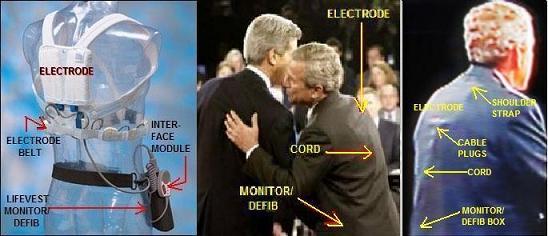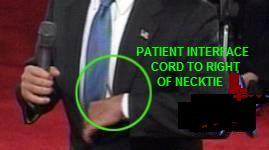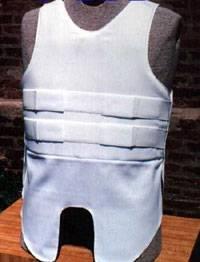George Bush: Physically and Mentally Ill?
C. L. Hallmark - 08.01.2005 07:15
GEORGE W. BUSH HAS WORN A HEART DEVICE AND WE SAW IT IN THE DEBATES (see photos below). We show the real reason for the Bush bulge and discount the bulletproof vest and "wired for cheating" theories. He didn't have a heart device installed internally because it would mean a revealing hospital stay. His doctor has admitted he has a heart condition that other doctors call an irregularity. He's not just accident prone: he probably has atrial fibrillation (AF), a heart arrhythmia. His father had it, increasing his risk about 50 percent. His father attributed his own AF to hyperthyroidism, a disease Bush Jr. may have inherited from both parents. AF is a cause of vascular dementia. As alternatives, physicians and others have noted symptoms of stroke, cognitive impairment, and Wernicke-Korsakoff syndrome, a disease associated with alcoholism.

Bush, Kerry

Handheld control

Most similar bulletproof vest

Easy to hide

Bush after pretzel incident

Symptoms of stroke, TIA
"According to doctors, George Bush has the lowest heartbeat ever recorded by
someone in the White House. Well, second lowest. Dick Cheney got his down to zero
a couple of times." -Jay Leno, alluding to George W. Bush's sinus bradycardia (slow heartbeat) and Vice President Cheney's implanted defibrillator.
"The President remains in supurb physical condition," said Adam M. Robinson, Jr., commander of the National Naval Medical Center in Bethesda, MD, after the president's fourth annual physical at the center, postponed until year's end.
"The doctors said that Mr. Bush had a 'low' to 'very low' risk of coronary artery disease, although they found evidence of minimal calcification of the coronary arteries themselves. As a preventative, they recommended that Mr. Bush take a daily aspirin [to prevent clotting] and a statin, or cholesterol-lowering drug," reported the New York Times.
YES, WE KNOW ABOUT IMPLANTABLE HEART STIMULATORS -- PACEMAKERS AND INTERNAL CARDIOVERSION DEFIBRILLATORS (ICDs). For at least two reasons, the president has avoided them and the medical reports have presented a rosy image: (1) The American people want a president who is up to the job physically and mentally, and. (2) from a personal pride standpoint, he wants to be remembered as another Rough Rider Roosevelt (Teddy) and not that other Roosevelt in the White House, FDR, who was in a wheelchair. The internal devices (ICDs) are implanted in the body and would not show through the clothes like the external wearable LifeVest. However, a hospital stay, like Vice President Cheney had to have his ICD installed in 2001, would be much harder to conceal than wearing a LifeVest, the external device we saw under Mr. Bush's jacket in the debates. A Republican ticket with two heart patients at the top would have been a harder sell in a close election (the Ticker Ticket?).
#file_1#
WE KNOW ABOUT BULLETPROOF VESTS. Soft body armor is invisible under a suit. It doesn't have a square patch with a wire leading down from it as in the photo above. (Show the photos to a police officer or police supply store.)
WE KNOW ABOUT COMMUNICATIONS RECEIVERS. Audio prompters and cueing receivers (for interpreters, etc.) are highly miniaturized today and easy to conceal. In 2005 one can buy a radio receiver in a pen for $5. Even 1950-era receiving equipment could be less obvious than what is in the photos. Mr. Bush wasn't "wired" for prompting. What you saw of his debating skills is what you get. (Show the photos to a vendor of "spy" devices or any electrical engineer.)
IT'S NOT A BAD SUIT DAY OR BAD SHIRT DAY. Mr. Bush gets his suits from the Washington tailor Georges de Paris (Frenchmen do have their uses), who charges $2500-$4500 for a suit. The president's tailoring is important to him. He doesn't have bad suit and shirt days; and if he did, the wrinkles wouldn't be the same rectangle and tail, on three separate days. (Show the photos to any tailor.)
However, there are still those pesky back shots from the debates, which the debate rules supposedly forbade. It is not clear when Mr. Bush first started wearing the LifeVest, whether he still wears it, or when he wears it. Normally it is worn by persons who are at elevated risk of sudden cardiac arrest or death after a heart operation or while waiting for an implantable cardioverter defibrillator (ICD, a device with wires implanted in the heart itself) to be installed or for antiarrhythmia medication to take effect.
HOW IS ATRIAL FIBRILLATION (AF) TREATED?
The purpose of AF treatment is to:
Restore normal heart rhythm
Control the heart rate
Prevent clots and decrease the risk of stroke
Many options are available to treat AF. These include medications, lifestyle changes, and many procedures such as cardioversion, ablation therapy, device therapy and surgery. The choice of treatment is based on the patient's heart rhythm and symptoms. (The LifeVest provides cardioversion -- electric shock to the heart muscle to restore normal rhythm -- when needed, within seconds. The president has been prescribed aspirin, as noted above.)
Medications
Different medications are prescribed to manage atrial fibrillation, depending on the overall treatment goal:
Restore normal heart rhythm: Many medications are available to restore and maintain a normal heart rhythm. These drugs (called antiarrhythmic drugs) include Quinidex (quinidine), Pronestyl (procainamide), Norpace (disopyramine), Toprol, Lopressor, Tambocor, Rythmol (propafenone), Betapace (sotalol), Tikosyn, and Cordarone. The patient may have to stay in the hospital when he first starts using these drugs so that the heart rhythm can be carefully monitored. (It is possible the president and his doctors decided to use the LifeVest instead of hospitalization.)
These medications are effective 30 to 60 percent of the time, but may lose their effectiveness over time. In general, they do not appear to prolong the lifespan of persons with AF, who have twice the mortality of the general population and five to seven times the likelihood of a stroke.
Many have potentially serious side effects including dizziness (feeling lightheaded and faint) and blurred vision. (If the president has been on these medications, the dizziness and blurred vision could account for his being accident-prone.)
Control heart rate: Control of the heart rate can be obtained using Lanoxin (digoxin) or two other groups of medications that control heart rate, called beta-blockers and calcium channel blockers. (These can cause the sinus bradycardia that Col. Richard J. Tubbs, the White House physician has said the president has.)
Prevent clots and stroke: Anticoagulant or antiplatelet therapy drugs (called blood-thinners), such as Coumadin (warfarin), are prescribed to reduce the risk of clots forming or stroke. Coumadin reduces the risk of stroke by 60 - 80 percent in people with AF. When Coumadin is used, regular blood tests are required to assure that the blood is thinned at a safe and effective level. (The genetic version of Coumadin, warfarin, also is the active ingredient in D-con. Some people, possibly President Bush, may be treated with aspirin instead of warfarin.)
(With the hearing loss noted on the exam report, aspirin normally would be contraindicated since it is ototoxic (it damages hearing). Therefore, there must be a strong therapeutic reason for prescribing aspirin to the president.)
Procedures
When medications do not work to correct or control AF, a procedure may be necessary:
If drugs are not able to control a persistent irregular heart rhythm (such as, AF), electrical cardioversion may be required. After administration of a short-acting anesthesia, an electrical shock is delivered to the chest wall to synchronize the heart and restore a normal rhythm. (This requires hospitilization and was considered for the president's father during his bout with AF in 1991. The LifeVest the president has worn performs cardioversion if the AF progresses to ventricular fibrillation, a quivering of the heart muscle that is ineffective in pumping blood and an acute emergency condition that is quickly fatal. The LifeVest can provide defibrillation in less than a minute, maximizing the chance for survival.)
Ablation therapy is an option for people who cannot tolerate medications or when medications fail to maintain the normal heart rhythm. Two types of ablation can be performed. One, ablation of the AV node, destroys the node. (It also slows the heart so much that a pacemaker must be installed. President Bush has a slow heart rate, previously attributed to his "supurb condition.")
Device Therapy
An implantable cardioverter-defibrillator (ICD) is a device designed to provide a person with the option to treat atrial fibrillation symptoms themselves. When the symptoms of AF occur, the person can turn on the device and treat the AF when appropriate and convenient. Alternatively, the device can be set to operate automatically. The ICD can be programmed to identify when a person is having an episode of atrial fibrillation. When it occurs, the device delivers therapy to convert AF to a normal heart rhythm. (Unfortunately, implanting an ICD involves a hospital stay, which a president could hardly conceal. When Vice President Cheney received an ICD in June 2001 to correct a funky rhythm, it was a big news story.)
(The LifeVest the president wore in the debate photos works like the automatic ICD, but it is used externally -- worn under the clothes. It is used until the medication works or an ICD can be implanted. )
THE PHOTOS SHOW A LIFEVEST
In contrast to the "fit for duty" report, the photos below show Mr. Bush at a presidential debate, with parts of a LifeVest wearable defibrillator clearly visible underneath his suit jacket. Again, the use of this avoided a hospital stay to install an implantable device (ICD), which would have given away the heart problem the president so clearly wants to hide. I realize he could have aforded the operation, but I believe he just didn't want to have it. Another reason some people opt for the external LifeVest instead of the internal ICD is they don't want to "go under the knife."
The LifeVest (left) has an electrode belt with four sensing/ECG electrodes. These send signals to the heart monitor/defibrillator, typically worn like a holster. When the monitor detects a life-threatening heart arrhythmia, it sends a signal to the small, handheld patient-interface module (a little like a computer "mouse" but with just buttons and alarms). The module provides an audible alarm. The user, if able to do so, depresses two buttons on the module to hold off a shock from the defibrillator. If the user faints and is unable to press the buttons, the defibrillator sends an electrical pulse to the large shocking electrode on the patient's back and a smaller one on the chest. The pulse can be repeated until the heart starts pumping blood effectively, up to five pulses. Again, this avoids the hospital stay involved with implanting an internal device (ICD). The ICD, by the way, does not require the large electrodes because it instead employs wires inserted directly into the heart, but that requires hospitalization.
In the center photo, showing Mr. Bush and Sen. Kerry at a debate, one can clearly see the shocking/therapy electrode between the shoulder blades as well as the electrical cord leading down to the monitor/defibrillator. Unlike other components associated with electronics, electrodes resist miniaturization, especially ones that must deliver substantial energy (150 joules in the LifeVest case) in a short time (less than 5 thousandths of a second) and overcome skin resistance. (As for the small square patch near Mr. Bush's ear in this photo, I do not know what it is. It IS an applied patch, man-made, and not just a video artifact.)
The photo on the right, from another debate, gives another view of the LifeVest components.
Below we see the president adjusting his necktie, and as he does so, revealing a gray cord like that on the patient-interface module ("mouse"), leading down to the monitor/defibrillator. The interface module possibly was fastened to his shirt, behind his tie. When a person goes to such lengths to hide the external LiveVest, can anyone doubt that he wishes to avoid giving away his status as a heart patient, which he would have to do to have an internal device installed?
#file_2#
BULLETPROOF VEST -- RIDICULOUS
Some sources have claimed that the back bulge is caused by a bulletproof vest. I have looked for body armor that would create a similar impression under a suit coat. The vest below is the closest I could find, courtesy Bullet Proof ME. It is a Pro MAX bulletproof vest, described as "designed for easy concealment under normal clothes." Clearly, he was not wearing a Pro MAX.
#file_3#
If the president's $2500-$4500 de Paris suits are worth that to him, surely he could find a bulletproof vest that would be inconspicuous, at taxpayer expense. Many are much easier to conceal than the one above, and one that is invisible under clothing is shown below.
#file_4#
RADIO RECEIVER/AUDIO PROMPTER -- A CONSPIRACY THEORY FOR THE ELECTRONICALLY CHALLENGED
No one who knows much about electronics takes this explanation seriously. Microminiaturization of electronics is so well known that the possibility of the bulge being the audio equivalent of a TelePrompter (an audio prompter) or a cueing receiver such as the ones used by interpreters, does not bear much discussion.
THEREFORE IT HAS TO BE AN ELECTRODE
"If it walks like a duck and talks like a duck," the saying goes, "it must be a duck." There's no need to search for anything else to call a duck. Same thing for the LifeVest. The first graphic above shows the LifeVest and the president side by side. The resemblance of what he is wearing to the LifeVest is unmistakable, unless you are one who looks for something else to call a duck or a LifeVest.
Some classes of electrical devices, such as transducers and electrodes, resist miniaturization and certainly don't follow Moore's Law. The electrodes of the LifeVest must overcome skin resistance and transfer 150 joules of energy into the body in less than 5 one-thousandths of a second. Even with the conductive gel it secretes, the LifeVest back electrode -- in two pieces side by side -- has an area of about 176 sq cm, or about 5-1/4 by 5-1/4 inches. This is the rectangular protrusion that we are seeing in the photos. Persons with no knowledge of electronics should consult someone who does if they believe the president was wearing a receiver to allow prompting by Karl Rove. This, by the way, saying that the president cheated in the debates, is more accusative than the explanation I have given, though not as threatening as having a president who suffers from dementia.
THE FAINTING INCIDENT OF JANUARY 2002
On January 13, 2002, President Bush lost consciousness while sitting on a couch in the White House, watching a football game. His head hit the floor, resulting in an abrasion on his left cheekbone and a small bruise on his lower lip. The incident was blamed on a combination of (a) Mr. Bush not feeling well in previous days and (b) an improperly eaten pretzel. Their combined effect was to slow the president's heart. The description suggests a vasovagal attack: A pretzel lodged in his throat stimulated the vagus nerve to send a signal to his heart, slowing it down and reducing blood flow so much he fainted, according to the White House physian, Col. Richard Tubb.
#file_5#
In this day of telemedicine, it is possible to do an operaton by remote control, 4000 miles away; but it is difficult and uncertain for anyone to diagnose physical illness without having access to examination and test records. (Remote diagnosis of mental illness often is easier.) That doesn't stop physicians from trying, especially since there is so much evidence on President Bush. Obviously, considerable testing and examination have been done; but the American public does not always have the latest results, as they found out after other presidents, including Roosevelt and Kennedy, left office. Besides photographic evidence, there are observations and quotes from doctors, based on hours of Bush TV appearances, voluminous reports in the media, and the president's own words.
GEORGE W. BUSH AND SYMPTOMS OF ATRIAL FIBRILLATION (AF)
In the January 2002 pretzel-choking episode, according to President Bush, the period of unconsciousness was brief -- a few seconds. When fainting begins and ends suddenly, the cause of fainting usually is not what his doctors reported (vasovagal syncope) but instead is an abnormal heart rhythm such as atrial fibrillation (AF). Chronic AF is consistent with Mr. Bush's requirement for constant monitoring and immediate access to defibrillation. Atrial fibrillation can lead to disastrous consequences if the patient is capable of sustaining a very rapid preexcited ventricular response with conduction over the accessory pathway. The rapid heart rate can produce syncope (fainting); or, more important, AF may cause ventricular fibrillation and sudden cardiac death. The LifeVest the president wears terminates ventricular fibrillation or ventricular tachycardia (overspeed) to prevent sudden cardiac death. This may be the reason the president wore the device during the debates, even though he risked exposing his vulnerability, especially if the device alarm sounded. Wearing it must have seemed very important.
According to the Framingham Offspring study of AF, a person whose parent had AF is 50 percent more likely to have it than the general population. President Bush's father had it during his presidency. While jogging at Camp David on a Saturday afternoon (May 4, 1991), Bush Sr developed shortness of breath, chest tightness, and a general feeling of fatigue. A White House physician discovered Bush had a rapid irregular heartbeat, ultimately diagnosed as atrial fibrillation. It may have been caused by Graves' disease, a form of hyperthyroidism (overactive thyroid) diagnosed shortly after.
Vagal-mediated AF is a well described phenomenon and often occurs in older athletes, which our current president, George W. Bush, is.
Hyperthyroidism, hypertension, and other diseases all can cause arrhythmias, as can recent heavy alcohol use (binge drinking). Some cases have no identifiable cause. The president says that he stopped drinking when he was 40, so binge drinking is not an issue. However, both of his parents have the Graves' disease form of hyperthyroidism. In general, if a person has Graves', about 50 percent of the offspring will have it. Bush's chances are even greater.
CHOLESTEROL-LOWERING STATINS
A class of medicines used for lowering cholesterol rather than for AF is statins. Statins, such as the one prescribed in the president's latest medical exam, are the most potent cholesterol-lowering agents, lowering LDL (so-called "bad cholesterol) by 30-50 percent. They are less effective than fibrates in lowering triglycerides and raising HDL ("good cholesterol"). But Bush's doctors said he had a "low" to "very low" risk of heart disease, and his total cholesterol level was listed as 170 mg/dL, which is considered within the normal range. Still they prescribed a statin.
There is ongoing research into other areas where statins appear to have an effect, including dementia. Science Daily recently reported (11/17/04): "The cholesterol-lowering drug atorvastatin slowed down mental decline and improved depressive symptoms in people with Alzheimer’s disease."
EVIDENCE OF STROKE OR TIA
The evidence of atrial fibrillation is strong, based on photographic evidence that Mr. Bush wears an antiarrythmic device, his father's having it, a confirmed sudden-fainting spell, numerous falls, and observation-at-a-distance. The evidence of a stroke or TIA is less strong. It is symptomatic and based on observation-at-a-distance -- TV appearances and news reports -- but it is there.
A stroke or TIA (transient ischemic attack) is one possible consequence of AF itself. A TIA basically is a mini-stroke.
Many observers, including physicians, have been concerned or even alarmed at the symptoms President Bush has evidenced in TV appearances.
The photo below shows the drooping mouth noticed by Dr. W. Kendall Tongier, M.D. of Dallas, Texas.
#file_6#
After watching the third presidential debate, Dr. Tongier posted on the Dallas Morning News website about his concerns that the president may have had a stroke. Dr. Tongier has been an anesthesiologist for 15 years. His post said:
"Having watched the first two debates from start to finish, I was looking forward to listening to a spirited debate between Bush and Kerry. Unfortunately, I barely heard a word that was said. Instead, I found myself staring at and concentrating on the president's drooping mouth."
"As a physician and a professor, I tend to pick up on signs and symptoms of physical problems better than most other people. I am highly concerned with what I saw. The drooping left side of the President's face, his mouth and nasolabial fold (the crease in the face running from the nostril to the side of mouth) may be indicative of a recent stroke, TIA (transient ischemic attack) or, possibly botox injections. I sincerely hope this was nothing more than botox injections. The other options are truly scary given an upcoming election for president in three weeks."
Not only was there no explanation, but the president delayed his annual medical examination until after the election. Even now, as far as I know, the complete details, including tests made and the metrics of those tests, have not come out -- only a few details and a conclusion that he is in "supurb condition." If the speculation is true, the writers of the president's medical report should be held to account for the discrepancies.
I have not observed the facial drooping in recent photographs of the president.
ONE ADMITTED HEART PROBLEM -- SINUS BRADYCARDIA
About 2 weeks after the president's January 2002 fainting spell, the White House physician, Col. Tubb, admitted that the president had experienced a condition called "sinus bradycardia," or slow heartbeat, for over 10 years and that it contributed to the fainting spell. Colonel Tubb attributed the low heart rate to the president's being "a highly conditioned athlete." However, professional athetes do not wear defibrillators to correct the rhythm of their "highly conditioned" hearts. In fact, sinus bradycardia is a heart arrhythmia, a rhythm malfunction, and President Bush is shown in photographs as wearing a LifeVest device for treating arrhythmias.
Bradycardia may be caused by certain medications, e.g., beta blockers, calcium-channel blockers or digoxin. These are the very drugs that are used to treat long-term atrial fibrillation.
DEMENTIA
The term "dementia" refers to a group of symptoms involving progressive impairment of all aspects of brain function. Disorders that cause dementia include conditions that impair the vascular (blood vessels) or neurologic (nerve) structures of the brain. Atrial fibrillation is a condition that can impair the brain's blood vessels by causing clotting.
One other type of dementia is caused by Wernicke encephalopathy, which is bleeding and swelling of the brain due to multiple brain lesions, caused by lack of thiamine vitamin. The thiamine deficiency often results from alcoholism. Mr. Bush drank, often heavily, according many published reports, from about age 20 to age 40. He said himself one time that he couldn't remember a day he didn't have a drink.
A minority of causes of dementia are treatable. Wernicke's can be treated with thiamine. If untreated long enough, the disease progresses to Korsakoff's syndrome, which like most of the disorders associated with dementia are progressive, irreversible, degenerative conditions.
The two major degenerative causes of dementia are (1) Alzheimer's disease, which is a progressive loss of nerve cells without a known cause or cure, and (2) vascular dementia, which is loss of brain function due to a series of small strokes. Vascular dementia may or may not play a role in the progression of Alzheimer's disease: the conditions often occur together and neither can be diagnosed definitively except until autopsy. In those with the genetic and environmental susceptibility to develop Alzheimer's disease, the concomitant presence of small infarcts (lacunar strokes) speeds up the onset of Alzheimer's disease to an earlier age than if it were to occur alone (i.e., without small infarcts). President Bush has been prescribed a statin, a cholesterol-lowering drug that, coincidentally, slows the progression of dementia, even though his overall cholesterol is within the normal range.
Dementia may be diagnosed when there is impairment of two or more brain functions, including: language, memory, visual-spatial perception, emotional behavior or personality, and cognitive skills (such as calculation, abstract thinking, or judgment). Dementia usually appears first as forgetfulness. Other symptoms may be apparent only on neurologic examination or cognitive testing and as the condition pregresses from mere cognitive impairment to true dementia.
A well-respected psychoanalyst has written a psychological profile of the president, called "Bush on the Couch: Inside the Mind of the President" (ISBN: 0060736704).
Justin A. Frank, M.D., is a clinical professor in the Department of Psychiatry at George Washington University Medical Center. Since 1980 he has been a teaching analyst at the Washington Psychoanalytic Institute. He is past president of the Greater Washington Chapter of Physicians for Social Responsibility. Dr. Frank lives and practices psychoanalysis in Washington, D.C.
Among the problems Dr. Frank found in Mr. Bush are megalomania, characterized by a Manichaean worldview, delusions of persecution and omnipotence, and an "anal/sadistic" indifference to others’ pain. The Manichaean tradition is a defunct religion with a "good cop/bad cop" theology.
The book follows Mr. Bush from childhood to now and analyzes the drinking problem, the bellicose rhetoric, the verbal flailings and misstatements of fact, the religiosity and exercise routines, the hints of dyslexia and hyperactivity, the youthful cruelty to animals and schoolmates
Below are some of the problems associated with dementias, including vascular and alcoholic (Wernicke-Korsakoff syndrome). Some of the things in this list were observed by Dr. Frank in Mr. Bush. Other items exist further along in the progression of the disease.
- progressive loss of memory
- inability to concentrate
- decrease in problem-solving skills and judgement capability
- persistence in failed problem-solving modes, "staying the course" at all costs (perseveration)
- confusion
- hallucination, delusions
- altered sensation or perception
- impaired recognition (agnosia) of familiar objects or persons
- altered sleep patterns
- MOTOR SYSTEM IMPAIRMENT
-----gait changes
-----inappropriate movements
-----other impairments of motor system
- disorientation
- inability to generalize, learn, think abstractly, or perform calculations
- MEMORY DEFICIT
----- short term (can't remember new things)
----- long term (can't remember past) Persons with this may make up stories to cover up nothing but the memory lapse itself. (confabulation)
- IMPAIRED LANGUAGE ABILITY
----- inability to comprehend speech
----- inability to read (alexia)
----- inability to write (agraphia)
----- inability to find words (aphasiia)
----- inability to repeat a phrase
----- persistent repetition of phrases or words (Much has been made of President Bush's use of the word "fabulous.")
- PERSONALITY PROBLEMS
----- irritability
----- poor temper management
----- anxiety
----- depression
----- indecisiveness
----- self-centeredness
----- inflexibility
----- no observable mood (flat affect)
----- inappropriate mood or behavior
----- withdrawal from social interaction
----- inability to function in social or personal situations
----- lack of spontaneity
Some of the above have been noted by Dr. Frank in the Bush book. Some have been noted by other MD's and by medical laymen, including members of the press.
Mr. Bush has had falls and accidents that have been well chronicled by the media and could be caused by motor-sysetem impairment, loss of muscle tone, dizziness, or blurrred vision. Diseases and medicines that cause these conditions have been described above. Most of these incidents have come at times of particular stress, which aggravates the diseases and which might require more medicine. They include:
January 2002: While watching a football game, Mr. Bush fainted and injured his face. This was a time of stress, 2 weeks before his post-9/11 State of the Union address.
May 2003: Mr. Bush fell off a Sedgway gyroscopically balanced 2-wheel scooter. Another stress -- 2 weeks before a trip abroad to line up support for the Iraq war.
August 2003: Mr. Bush dropped his dog Barney as Mrs. Bush handed him the dog at the TSTC Airport in Waco, Texas, to the horror of onlooking schoolgirls. (Imagine their horror if it had been a baby.) In little over a week he would give only his second (the first was to announce the start of the war on Iraq) address to the nation defending the yellowcake/Wilson/Plame matter, the WMD deadend, and the growing insurgency in Iraq -- arguably his most important national address to date. This was a time of stress.
May 2004: Two days before one of very few and arguably the most important prime-time speech of his, in which he defended the Iraq war in the wake of Fallujah and Najaf unrest, Mr. Bush fell off his mountain bike and injured his face again. His approval rating was 41 percent, the lowest of his presidency, at this time of stress.
June 4, 2004: Mr. Bush appeared with a scatch on his right cheek. Had he fallen again or was it some other kind of accident?
Additional symptoms that may be associated with organic brain disease include swallowing problems. However, this and some of the above are also symptoms of hyperthyroidism.
HYPERTHYROIDISM (OVERACTIVE THYROID)
When one of a person's parents has hyperthyroidism, one cause of AF episodes and the cause in his father's case, the chances are that 50 percent of their children will have it. Both of President Bush's parents have Graves' disease, increasing his chances of getting it even more.
The symptoms that Mr. Bush has presented include: choking on foods, irregularities in heart rate, fainting or dizziness; sensitivity to light and a continual feeling that there is something in the eyes (evidenced by rapid eye-blinking during the debates), atrial fibrillation; restlessness, heat intolerance (the debate rules called for the room temperature to be kept below 70 degrees), muscle weakness in the upper arms and thighs (the president dropping his dog?), nervousness and irritability, and erratic behavior.
The president's father was diagnosed with Graves' disease, a form of hyperthyroidism in 1991, within 18 months of Barbara Bush being diagnosed with the same thing. The chances of this happening to two unrelated persons in such a short time is about 1 in 3 million. Because of the remarkable coincidence, the Secret Service tested the water in the White House, at Camp David, at the Vice President's residence, and at Walker's Point (Bush's home in Maine) for lithium and iodine, two substances "known to cause thyroid problems." The lead investigator was Dr. Kenneth Burman, then a colonel in the Army medical corps (the same man whom the media is quoting about the thyroid cancer of Chief Justice Rehnquist).
CONCLUSION
The president used a wearable defibrillator, a device to stop heart arrhythmia, as seen in photographs of the debates with Sen. Kerry. His doctor admits he has an arrhythmia, sinus bradycardia. He has had a sudden fainting spell and other symptoms of another arrhythmia, atrial fibrillation (AF), and has a genetic tendency for it. Some observers have noted neurological and psychological irregularities and other evidence of stroke or vascular dementia, possible results of AF. Some of these irregularities could be caused by Wernicke-Korsakoff's, a disease of inveterate alcoholics, or some other organic brain disease. The president has an even stronger genetic predisposition for hyperthyroidism and some symptoms of it, including a heartbeat arrhythmia and erratic behavior. Only his doctors know for sure.
|






